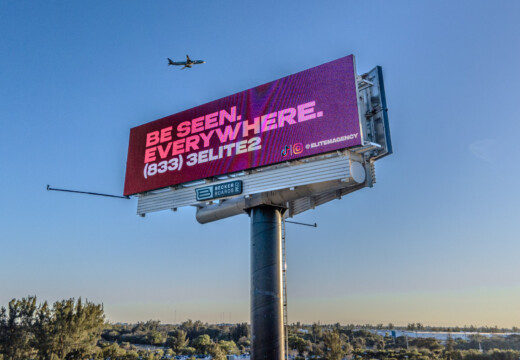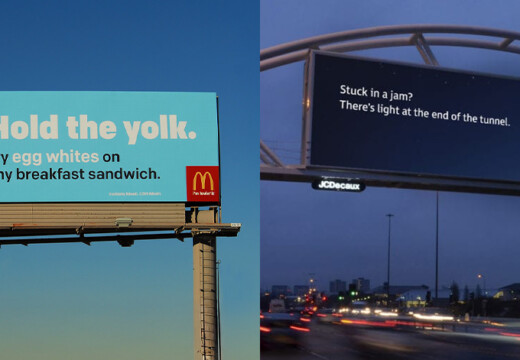CPM (Cost Per Thousand Impressions) helps advertisers measure the cost-effectiveness of billboard ads. It shows how much it costs to reach 1,000 people. Here’s how to calculate it:
- Formula:
CPM = (Total Campaign Cost ÷ Total Impressions) × 1,000 - Example:
If a billboard costs $3,500/month and generates 175,000 impressions:
($3,500 ÷ 175,000) × 1,000 = $20 CPM
Key Factors Influencing CPM:
- Location: Urban areas cost more but reach larger audiences.
- Billboard Type: Digital billboards offer flexibility but may have higher CPMs.
- Timing: Peak hours or seasons can increase CPM rates.
Common Mistakes to Avoid:
- Misaligning costs and impression timeframes.
- Overestimating impressions by counting vehicles instead of viewers.
- Ignoring traffic variations.
Use accurate traffic data and consider factors like visibility and audience demographics to refine your campaign’s efficiency.
CPM Calculation Formula
Basic CPM Formula
To calculate billboard CPM, use the formula:
CPM = (Total Campaign Cost / Total Impressions) × 1,000
Here’s how it works: divide your total campaign cost by the total number of impressions, then multiply the result by 1,000. This formula gives you the cost per thousand impressions, where:
- Total Campaign Cost is the full amount spent on the campaign.
- Total Impressions represents the total number of people who see the ad.
- Multiplying by 1,000 adjusts the result to reflect cost per thousand viewers.
For example, if a monthly billboard campaign costs $3,500 and reaches 175,000 viewers:
($3,500 / 175,000) × 1,000 = $20 CPM
This simple calculation helps you understand the cost-efficiency of your campaign.
Sample Urban Billboard CPM
Let’s look at an example from a digital billboard on I-95 in Miami, Florida:
| Campaign Details | Values |
|---|---|
| Monthly Cost | $2,800 |
| Daily Traffic | 65,000 vehicles |
| Average Viewers/Vehicle | 1.5 people |
| Monthly Impressions | 2,925,000 |
| Calculated CPM | $0.96 |
This example highlights how high-traffic urban locations can dramatically lower CPM due to the sheer number of impressions generated.
Calculation Mistakes to Avoid
When calculating CPM, it’s easy to make errors that skew results. Here are some common mistakes and how to prevent them:
| Error | Impact | Prevention |
|---|---|---|
| Using daily instead of monthly costs | Understates CPM | Match costs to the same timeframe as impression data |
| Counting vehicle traffic as viewers | Inflates impression count | Use accurate multipliers for passengers and repeat views |
| Ignoring peak traffic hours | Misrepresents impressions | Account for traffic variations throughout the day |
To ensure precise CPM calculations:
- Double-check traffic data sources for accuracy.
- Include all associated campaign costs, not just the billboard rental fee.
- Factor in seasonal traffic changes and external conditions like weather or daylight hours that can impact visibility.
Digital billboards often simplify this process with real-time analytics and automated tracking, providing more accurate CPM figures.
Up next, we’ll explore the key factors that influence CPM rates.
What Is CPM? Marketing and Advertising CPM Explained For Beginners
CPM Rate Factors
Once you know how to calculate CPM, it’s time to explore the factors that influence its rates.
Location Effects
The placement of a billboard plays a massive role in determining its CPM rates. Urban locations with heavy commuter traffic often command CPMs that are 3–5 times higher than rural spots. This is largely due to higher commuter density and better engagement opportunities. Here are some key factors that can increase a location’s value:
- Traffic speed: Slower-moving traffic means longer viewing times.
- Proximity to commercial hubs: Being near shopping centers or business districts boosts exposure.
- Unobstructed visibility: Clear sightlines make a big difference.
- Demographics of passing traffic: Who sees your ad matters just as much as how many see it.
| Location Type | Average CPM | Daily Traffic | Key Benefits |
|---|---|---|---|
| Urban Highway | $5–7 | 150,000+ | High visibility, dense audience |
| Suburban Area | $3–5 | 75,000–100,000 | Steady commuter exposure |
| Rural Highway | $1–2 | 25,000–50,000 | Lower competition, targeted reach |
Now, let’s look at how the type of billboard – digital or static – affects CPM rates.
Billboard Type Comparison
Digital and static billboards have unique characteristics that influence their CPM rates. Here’s a quick comparison:
| Feature | Digital Billboard | Static Billboard |
|---|---|---|
| Average CPM | $2.50–$8.00 | $1.50–$5.00 |
| Ad Flexibility | Rotating multiple ads | Fixed single display |
| Production Costs | Lower (digital files) | Higher (printing/installation) |
| Minimum Duration | As short as 1 day | Typically 4–12 weeks |
| Targeting Options | Time-based, dynamic | Fixed audience only |
Digital billboards stand out for their flexibility. They allow advertisers to adjust content dynamically and target specific time slots (a practice known as dayparting). With pay-per-play models, CPMs for digital ads can drop to as low as $0.50–$2.00, making them a cost-effective option for smaller businesses.
Beyond format and location, timing also plays a crucial role in shaping CPM rates.
Time-Based Rate Changes
Timing is everything in advertising, and CPM rates often fluctuate based on the time of day and season. High-traffic periods, like summer and the holiday season, can push CPMs up by 10–25%. Morning rush hours (6–9 AM) and evening commutes (4–7 PM) typically command higher rates, while off-peak hours might see discounts of 25–40%. Weekend traffic patterns, however, can vary depending on the area.
sbb-itb-2e2e93f
CPM Calculation Guide
Finding Impression Data
Accurate impression data is the backbone of CPM calculations. To get reliable traffic figures, consider these sources:
- Department of Transportation (DOT) Reports: Your state’s DOT website often provides official traffic counts.
- Digital Billboard Analytics: Many digital billboards now offer real-time impression tracking, giving you up-to-date data.
When gathering data, pay attention to these critical metrics:
| Metric | Description | Impact on Calculations |
|---|---|---|
| Vehicle Count | Average daily traffic volume | Forms the baseline for impressions |
| Speed Limit | Traffic flow rate | Affects how long ads are visible |
| Visibility Distance | Clear viewing range in feet | Determines exposure duration |
| Peak Hours | High-traffic periods | Impacts impression quality |
These metrics help you lay the groundwork for accurate campaign calculations.
4-Week Campaign Example
Let’s break down a sample campaign:
- Total Cost: $2,800
- Location: Urban highway
- Daily Traffic: 85,000 vehicles
- Campaign Duration: 28 days
- Visibility Factor: 75% (a common industry benchmark)
Here’s how to calculate CPM step by step:
- Determine Total Impressions:
Multiply daily traffic by the visibility factor:
85,000 × 0.75 = 63,750 impressions per day.
Then, multiply by the campaign duration:
63,750 × 28 = 1,785,000 total impressions. - Apply the CPM Formula:
Divide the total cost by total impressions, then multiply by 1,000:
($2,800 ÷ 1,785,000) × 1,000 ≈ $1.57.
For an easier process, platforms like Blip offer real-time data to simplify these calculations.
Spreadsheet Calculation Tips
Spreadsheets can make managing CPM data more efficient. Here are some handy formulas:
| Function | Formula Example | Use |
|---|---|---|
| Basic CPM | = (Total Cost / Total Impressions) * 1000 |
Standard CPM calculation |
| Daily Average | = (Daily Cost / Daily Impressions) * 1000 |
Track daily performance |
| Weekly Trends | = AVERAGE(Week_CPM_Range) |
Analyze weekly patterns |
For more complex campaigns, consider using separate worksheets. Add conditional formatting to highlight high CPM rates and automate calculations for real-time insights. This approach saves time and ensures accuracy.
CPM Performance Improvement
Once you’ve calculated your CPM, the next step is to make strategic adjustments that can stretch your budget and enhance the impact of your billboard campaigns.
Audience Targeting
Focusing on the right audience is key to lowering CPM while increasing the effectiveness of your campaign. Digital billboard platforms make this easier by allowing advertisers to choose locations based on performance data. This ensures your ad dollars are spent wisely and deliver better results.
Take Mr. Charlie’s Chicken Fingers as an example. Owner Paul Willey shares how targeted advertising helped his business:
“Working with Blip has given Mr. Charlie’s the momentum to get our new location on the map while accelerating growth for our original location”.
Once you’ve nailed down your audience, the next step is to refine your ad design to grab attention and drive engagement.
Ad Design Impact
A well-designed ad can make all the difference. Clear visuals combined with concise, impactful text help grab the attention of your audience. By focusing on strong branding and simplicity, your message becomes more memorable to people passing by. Thoughtful design choices not only improve engagement but also leave a lasting impression.
Campaign Timing
Timing plays a crucial role in CPM performance. Scheduling your ads during peak audience activity ensures better visibility and maximizes the value of your investment. By studying traffic patterns and audience behavior, you can pinpoint the best times to display your ads for maximum impact. Kimberly Pinkson, Owner of Pretty In Pinkston, highlights the importance of timing:
“Blip works for us. It’s a different medium, and it brings a lot of exposure. It sets us apart from the rest of the [competition], and that’s what I like”.
Summary
Understanding CPM calculations is crucial for running cost-efficient billboard campaigns. By using the standard CPM formula, advertisers can evaluate different billboard options and make smarter budget decisions. Applying this data strategically can significantly boost campaign results. Here are some important elements to consider when refining your approach:
- Location: The placement of a billboard directly impacts the quality of impressions and the overall reach of your campaign.
- Digital Billboard Advantages: Digital billboards offer flexibility, making it easier to engage with a broader audience.
- Performance Tracking: Regularly monitoring performance ensures you can adjust and improve the CPM efficiency of your campaigns.
FAQs
How can I ensure my billboard campaign’s impression data is accurate?
To get accurate impression data for your billboard campaign, it’s important to use platforms that base their calculations on trustworthy and transparent data sources. Many digital billboard platforms, for instance, rely on traffic data from well-established sources. They consider factors like location, time of day, and audience demographics to provide reliable insights.
If you’re working with Blip, you can feel confident that their impression data comes from a detailed analysis of updated metrics. Plus, Blip offers analytics tools that allow you to track your campaign’s performance. These tools give you clear insights, making it easier to confirm your results and make adjustments to improve your campaign.
How can I reduce the CPM for my digital billboard ads?
To bring down the cost-per-thousand impressions (CPM) for your digital billboard ads, consider these strategies:
- Pick high-traffic spots and times: Select billboard locations and schedules that align with when your target audience is most likely to see them. Timing and placement matter.
- Refine your ad design: Ads that are visually engaging and have a clear, concise message grab attention more effectively, making your investment work harder.
- Use flexible bidding options: Platforms like Blip let you tweak your budget and bidding strategy in real time, allowing you to secure impressions at better rates.
These approaches can help you stretch your advertising dollars further while boosting your campaign’s impact.
How do digital and static billboards impact the cost-effectiveness of your advertising campaign?
The decision between digital and static billboards can play a big role in how well your campaign performs, depending on your goals and budget. Digital billboards offer flexible scheduling, meaning you can show ads at specific times or rotate multiple designs. This approach helps boost visibility while minimizing wasted impressions. Plus, with their pay-per-play model, you’re only charged when your ad actually runs.
On the other hand, static billboards come with a fixed cost for continuous display but don’t offer the same flexibility or real-time updates as digital options. Static billboards work well for building long-term brand awareness, but digital billboards often shine in short-term or highly targeted campaigns. Tools that allow you to track performance and make real-time adjustments add even more value to digital campaigns. Platforms like Blip, for example, provide transparent pricing and detailed analytics, helping you get the most out of every dollar spent.
To get accurate impression data for your billboard campaign, it's important to use platforms that base their calculations on trustworthy and transparent data sources. Many digital billboard platforms, for instance, rely on traffic data from well-established sources. They consider factors like location, time of day, and audience demographics to provide reliable insights.
If you're working with Blip, you can feel confident that their impression data comes from a detailed analysis of updated metrics. Plus, Blip offers analytics tools that allow you to track your campaign's performance. These tools give you clear insights, making it easier to confirm your results and make adjustments to improve your campaign.
"}},{"@type":"Question","name":"How can I reduce the CPM for my digital billboard ads?","acceptedAnswer":{"@type":"Answer","text":"
To bring down the cost-per-thousand impressions (CPM) for your digital billboard ads, consider these strategies:
- Pick high-traffic spots and times: Select billboard locations and schedules that align with when your target audience is most likely to see them. Timing and placement matter.
- Refine your ad design: Ads that are visually engaging and have a clear, concise message grab attention more effectively, making your investment work harder.
- Use flexible bidding options: Platforms like Blip let you tweak your budget and bidding strategy in real time, allowing you to secure impressions at better rates.
These approaches can help you stretch your advertising dollars further while boosting your campaign's impact.
"}},{"@type":"Question","name":"How do digital and static billboards impact the cost-effectiveness of your advertising campaign?","acceptedAnswer":{"@type":"Answer","text":"
The decision between digital and static billboards can play a big role in how well your campaign performs, depending on your goals and budget. Digital billboards offer flexible scheduling, meaning you can show ads at specific times or rotate multiple designs. This approach helps boost visibility while minimizing wasted impressions. Plus, with their pay-per-play model, you’re only charged when your ad actually runs.
On the other hand, static billboards come with a fixed cost for continuous display but don’t offer the same flexibility or real-time updates as digital options. Static billboards work well for building long-term brand awareness, but digital billboards often shine in short-term or highly targeted campaigns. Tools that allow you to track performance and make real-time adjustments add even more value to digital campaigns. Platforms like Blip, for example, provide transparent pricing and detailed analytics, helping you get the most out of every dollar spent.
"}}]}


